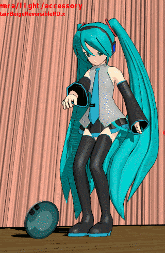MikuMikuMoving
... A different program!
When you open up MMM, it looks
different and it
has a different setup ... and it's not like how MMD works!
You see that icons, tabs and buttons
are in different places and it takes a
while to figure out how to delete motions, load stages, render videos,
and so
on.
You can load a model by clicking on the
"Load Model"
button, up at the top in the File tab, or you can click the
button
down at the bottom left. Then you
can select your model and open it up. Like MMD, MMM tells you the model
information. MMM doesn't include any basic models ... so you will want
to download MMD to get hold of the Model folder containing Miku and her
friends.
Next to the Load Accessory icon and the
Remove icon, up
the top and at the bottom, there is another icon called Import Motion.
To
delete a motion, go to the edit tab and press select all and click on
Remove. And next to Import Motion, is Import Pose.
You can also see other icons that allow
you to
import an effect, with that, you can assign and enable effects. You can
Load Audio and Load VSQ. So by clicking on these icons, you can load up
a
file just like MMD!
By just looking at the File tab, you
can also see
icons for you to open project files, render to picture, render AVI and
settings.
In settings, you can set your screen
size, adjust
things, and set MMM to the way you want it to work.
As you can see, below the frame bars,
there is a tab that says Sequence and below the Sequence tab is a line
from
negative to positive, that makes all your frames smaller or bigger in
size, that shows your motion data, and an Audio tab that shows your
audio.
But, if you can see the tracks in the
Audio tab,
it allows you to put in more than one song or a sound effect! Also, you
can add another
track by clicking on Add another track icon next to the scribble
looking icon above the sequence tab.
The caption icon allows you to put
captions in
your video, they are also called subtitles or teletext and if you see
the letter T above the star down at the bottom left, that tab allows to
you make your subtitles big, small, bold, set the duration at frames,
set the letter space and colour!
In the other tabs, you can look at your effects and plugins as well.
Now focusing on your model in the
models tab, you
can see the interpolation curve and the letters beside it stand for
Rotation, the axis X,Y and Z and Motion. You can also see the copy and
paste icons down the bottom. Next to that, you can see the Visible,
Self Shadow, Add Blending and Physics.
Also, looking at the Edge, that will
help you with
the thickness of the model and the edge colour. Next to the IK boxes,
you can see the smiley face icon that will help you with motion of the
mouth, eyes, brows and etc. But there is no select all button, you can
right click on the screen next to your model that selects all the bones
or you can move your mouse around the model that will show the bones.
Now, if you see the hand icon, to your
surprise,
with that tab, you can automatically set the model hands to a fist!
That's almost like cheating isn't it???
With the blue icon, you can position
your model to
an exact spot, place or angle.
The accessories icon allows you to set
your accessory to a bone just
like the MMD setup but the camera settings give you lightning, light
colour, gravity, self shadow settings, tone Cures, gray scales, and the
normal camera settings.
The star icon is for the effect
settings. If you
can see on the right down the bottom, you can set the camera to a bone,
model and set it to the front, back, left, right, up, down, and back to
the normal camera view. There is the volume as well.
You can set your screen to black or
white in the
screen tab and turn off the axis in the view tab up the top. If you
notice when you import an audio file, in the audio tab, you can drag
the audio track to a frame!!! No more editing!!!
And if you see the play button, the
play button
turns into a stop button when your playing your video and you can pause
it as well, however, it does not go back to frame 0, it pauses at the
frame you stopped at. Looking at the tick icon, that's to register
bones, accessories etc to a frame.
The Kinect settings and the recording
buttons in
the Kinect tab are just like the ones in MMD so you should be familiar
with them if you use Kinect.
When you are going to render, it
already sets 0 to
your ending frame already but it doesn't do it the second time when you
make a video if you didn't turn off MMM before loading it up back again
for a new one. But now it asks for screen size, video compressor,
background, present and background. Don't forget to give it an output
file!
When you click on Start Render, it
doesn't change
to a big screen recording, it simply starts rendering in the small
screen of the program and the small window starts showing you where
it's at in percentage and when it's up to 100%, the render finishes and
the small window goes away.
Now that's the basics! Have fun playing
with MMM,
there are still a lot more things to discover!
Kazuki Matsuoka
|
